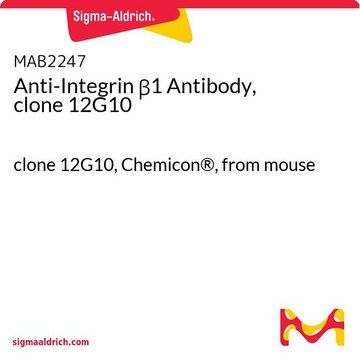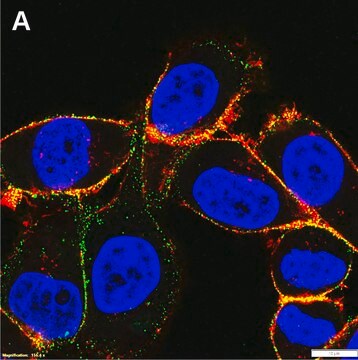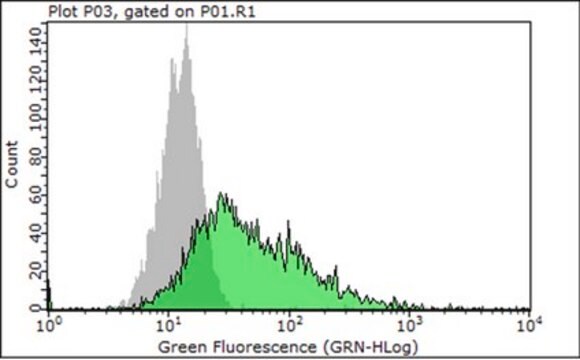MAB1959
Anti-Integrin beta 1 (CD29) Antibody
CHEMICON®, mouse monoclonal, P5D2
Sinónimos:
CD29, MAB1959Z
About This Item
Productos recomendados
Nombre del producto
Anti-Integrin β1 Antibody, clone P5D2, clone P5D2, Chemicon®, from mouse
biological source
mouse
Quality Level
antibody form
purified immunoglobulin
antibody product type
primary antibodies
clone
P5D2, monoclonal
species reactivity
human
manufacturer/tradename
Chemicon®
technique(s)
ELISA: suitable
flow cytometry: suitable
immunocytochemistry: suitable
immunohistochemistry: suitable
immunoprecipitation (IP): suitable
isotype
IgG2bκ
NCBI accession no.
UniProt accession no.
shipped in
wet ice
target post-translational modification
unmodified
Gene Information
human ... ITGB1(3688)
General description
Specificity
Immunogen
Application
Immunohistochemistry: A representative lot of this antibody clone was used in immunohistochemistry (acetone fixation, no paraffin embedding).
ELISA: A representative lot of this antibody was used in ELISA.
Immunocytochemistry: A representative lot of this antibody clone was used in immunocytochemistry (paraformaldehyde fixation at less than 4%).
Functional Activity Assay: A representative lot of this antibody clone was used in cell attachment assay of SV-HFO cells with a characteristic spread morphology. In the presence of function-blocking mAbs to β1 integrin (P5D2), the cells attached but no longer spread, and displayed a rounded morphology with many cytoplasmic projections (Iba, K. et al., 2000).
Cell Structure
Integrins
Quality
4 µg of the antibody was used to detect Integrin β1 in 1x10^6 A431 cells.
4 µg of the antibody was used to detect Integrin β1 in 1x10^6 HeLa cells.
Physical form
Storage and Stability
Analysis Note
Human tonsil, human skin tissue
A431 & HeLa Cells
Other Notes
Legal Information
Disclaimer
¿No encuentra el producto adecuado?
Pruebe nuestro Herramienta de selección de productos.
Optional
Storage Class
10 - Combustible liquids
wgk_germany
WGK 2
flash_point_f
Not applicable
flash_point_c
Not applicable
Certificados de análisis (COA)
Busque Certificados de análisis (COA) introduciendo el número de lote del producto. Los números de lote se encuentran en la etiqueta del producto después de las palabras «Lot» o «Batch»
¿Ya tiene este producto?
Encuentre la documentación para los productos que ha comprado recientemente en la Biblioteca de documentos.
Nuestro equipo de científicos tiene experiencia en todas las áreas de investigación: Ciencias de la vida, Ciencia de los materiales, Síntesis química, Cromatografía, Analítica y muchas otras.
Póngase en contacto con el Servicio técnico







